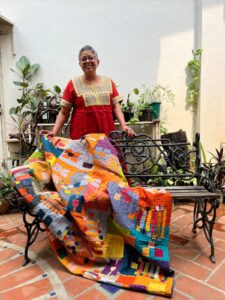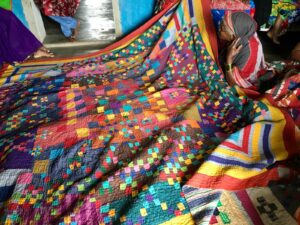Vibrant patchwork quilts, adorned with multilayered narratives, grace the homes of every Siddi in the villages of Uttara Kannada.

Siddi women, drawing from a rich tradition spanning centuries, skillfully create the Kavandi quilts. (Anitha N Reddy)
In the remote villages of Karnataka, hidden from the prying world of social media, a mesmerising tradition of artistic expression thrives: the enchanting Kavandi quilts, skillfully woven by the gifted hands of Siddi women.
These exquisite quilts embody an incredible heritage, intertwining history, culture, and art.
Siddi women, drawing from a rich tradition spanning centuries, skillfully create these quilts through meticulous handcrafting techniques, utilising stitches such as back and running stitches.
Each quilt they produce is a masterpiece, a magnificent mosaic of vibrant colours and intricate patterns, reflecting the rich tapestry of their beliefs and customs.
Though Siddi women may not have precise knowledge of the origins of these quilts, known as Kavandi, they are well aware of their practical role.
These quilts, highly functional and meticulously woven by married women, serve the essential purpose of providing warmth during the winter and comfort in the cool rainy season.
The Siddis’s historical presence in the Indian subcontinent is believed to be the result of their forced migration as slaves, brought by Arab, Portuguese, and other European traders.
This migration dates back to the early medieval period and, over time, they have settled in diverse regions such as Karnataka, Maharashtra, and Gujarat.
In Karnataka, the Siddis predominantly settled in the Uttara Kannada district, particularly in the regions of Yellapur, Ankola, and Haliyal.
In Maharashtra, they can be found in areas such as Janjira, Bhimashankar, and parts of Raigad district. Additionally, some Siddi communities are present in the Gir Forest region of Gujarat.

Anitha N Reddy, is an artist, researcher and curator. (Supplied)
Anitha N Reddy, an artist, researcher, and curator who has worked with the community for a decade, places the population of Siddi between 50,000 and 70,000, with 25,000 Siddi women working on quilts for their families.
Using worn-out saris, blouses, shirts, and pants, they piece together frill-free quilts with geometric or abstract designs.
Reddy explains, “There is one basic layer of a synthetic sari with pieces of cloth stitched onto it. The imagery is minimal, except for instances when it is crafted for a newborn or a special occasion.”
“In any case, as they inhabit deep forests, they lack access to a wide range of materials. The primary objective is to keep themselves warm,” she shares, emphasising that it is primarily an activity for domestic purposes.
It is interesting to note that this craft was never intended as a collective activity for commercial purposes. Instead, once married, women would weave these quilts in the comfort of their marital homes.
“The skill was never passed on from one generation to another. Girls learnt it just by watching their mothers,” notes Reddy.
One master quilter told Reddy that when she went to her marital home, there was nothing to keep her warm. So, she started making these quilts.
“She made many for the entire family, as you can’t just make one for yourself,” she says.
The senior artist has developed a platform called Siddi Kavand, empowering Siddi women to showcase and market their art globally.
Working with around 70 Siddi women from villages in Belagavi, Uttara Kannada, and Dharwad, she regularly visits these villages with discarded cotton fabric to support the creation of kavands.
With the introduction of diverse and more colourful fabric from the city, the kavands’s visual vocabulary has evolved significantly. They now boast a vibrant array of colours and intricate imagery.
“I am also a psychoanalyst, so I go and live with them and have conversations about their lives and aspirations. Suddenly, I see trees or impressions from their lives come up in their work,” she explains.
The Siddi artisans have transcended the traditional form of simply weaving blankets for two people.
They now create comforters, bed covers, and single quilts, varying in price from ₹8,000 to ₹13,000, based on size and complexity.
Every artisan earns between ₹5000-₹8000 per month.

These quilts, meticulously woven by married women, serve the purpose of providing warmth during the winter and comfort in the cool rainy season. (Supplied)
Reddy’s commitment to showcasing the Siddi women’s art goes beyond just selling it online. She actively participates in fairs and exhibitions, providing a broader platform for their textile tapestries to captivate viewers.
The Urban Fabric Exhibition held in 2019 proved to be a momentous event, where Reddy welcomed the Kavandis and their creators to Chitrakala Parishath.
The vivid textile tapestries left every viewer, including the writer, enthralled and excited.
Reddy informs us that even as we speak, the quilts are being showcased at the House of the World Cultures (HKW) in Berlin.
Such engagements have gone beyond financial empowerment and brought about transformative changes in their lives.
As part of their artistic journey, when the Siddi artisans visited Bengaluru, Reddy ensured they experienced the city’s cultural landmarks.
From the Vidhana Soudha (Secretariat and State Legislative building) to Lal Bagh and Cubbon Park, the artisans were exposed to new and exciting places.
“One of them called their husbands and said, ‘Look! you haven’t been to these places but I have’. They have never been out of their villages because of various reasons like permission from their husbands, their own hesitation, and financial issues. So, visiting Bengaluru was a big occasion for them,” shares Reddy.
Siddis are a community facing landlessness due to limited access to rights and resources. They communicate through a unique blend of Konkani and Marathi languages.
Siddi men sustain their livelihoods by engaging in various labour-intensive occupations such as working as farm labourers, participating in fisheries, and contributing to construction projects.
Additionally, they depend on forest resources, including honey, as a means of earning a living.
Selected by 1 Shanthiroad, an artist-led space in Bengaluru, Reddy was recently invited by the Australian Centre for Contemporary Art to present a work, Hinged By Fabric, as part of the Atlassian Wonderspace programme.
The programme empowers creatives worldwide to explore innovation through immersive temporary workplace exhibits.
Collaborating with Siddi women quilters, Reddy created three installations and conducted workshops as part of the programme.
During one of the workshops, when Anitha asked the women to share their thoughts, some of them were moved to tears, reflecting the emotional impact of their journey.
“They said, ‘just to be able to talk is an opportunity. Nobody has ever asked us to talk,” she recalls.
Kavandi quilts go beyond their captivating aesthetics, holding profound significance as they visually narrate the rich history of the Siddi community.
These quilts portray the remarkable journey of Siddis from African shores to the Indian subcontinent, preserving tales and traditions that have endured through the ages.
Furthermore, these quilts stand as a powerful testament to the unwavering spirit of Siddi women, showcasing their resilience, creativity, and wisdom in the face of challenges.
To get a glimpse of their lives and their vibrant weaves, visit Instagram @anithanreddy

Jul 27, 2024

Jul 26, 2024

Jul 26, 2024

Jul 26, 2024

Jul 26, 2024

Jul 26, 2024